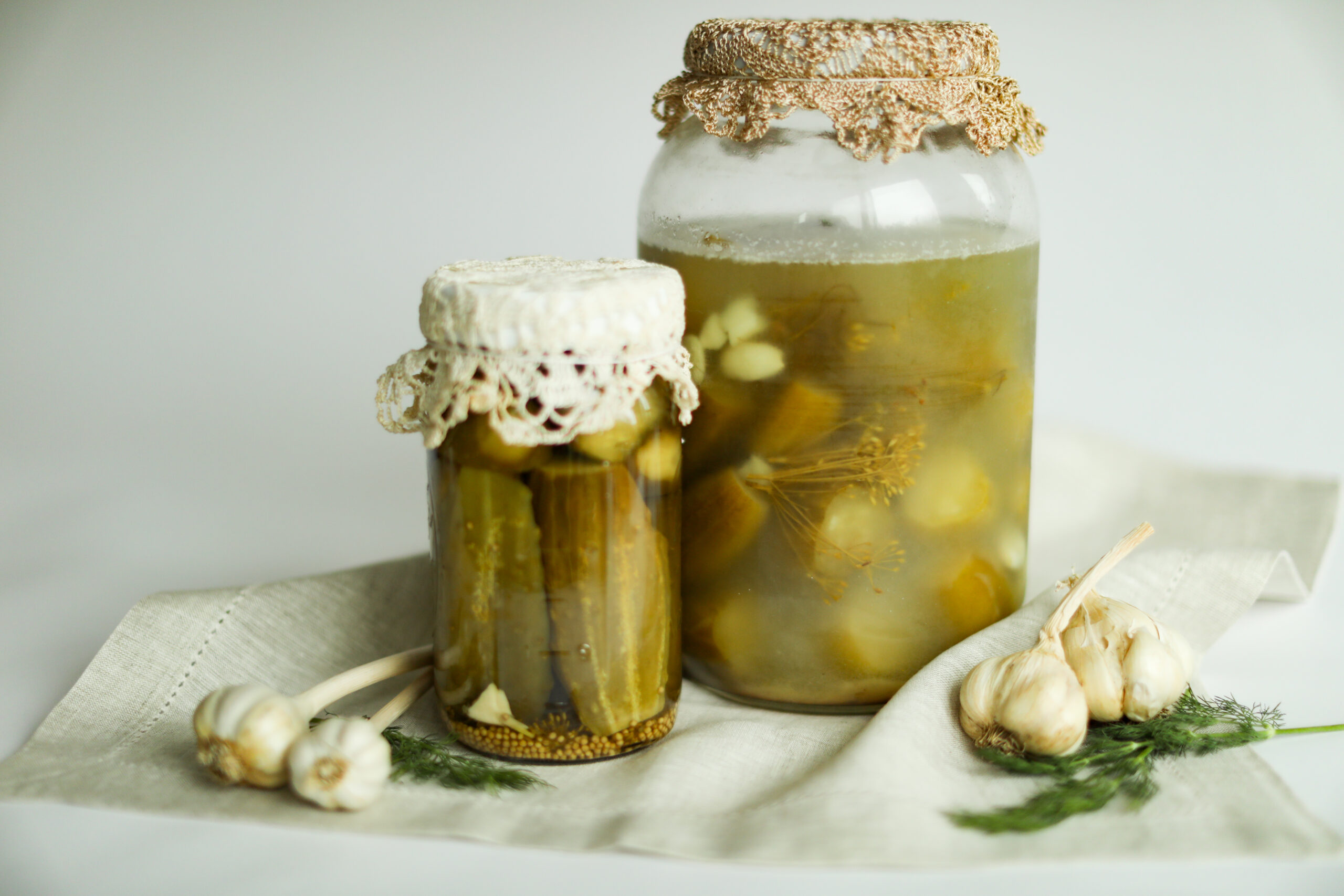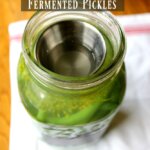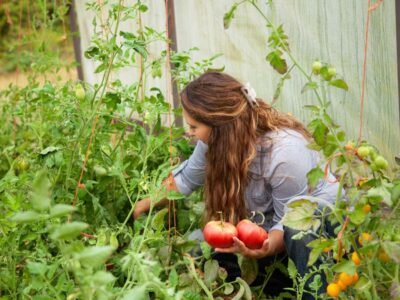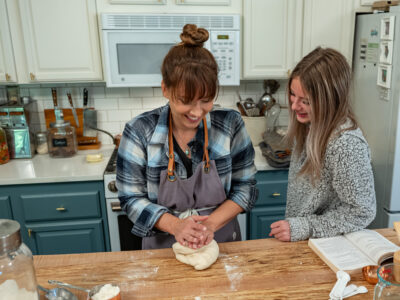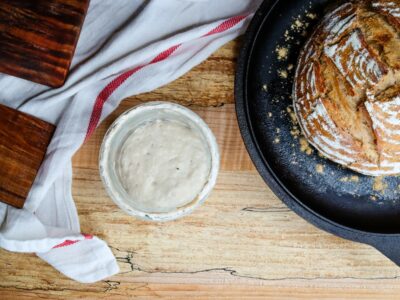Ever needed a fermented pickle recipe? Yes, the answer is yes. This quick and easy fermented pickles recipe includes both garlic and dill, is naturally fermented, and results in a salty and sour pickle that's both crunchy and reminiscent of a classic old-fashioned deli pickle. Unlike water-bath canned pickles made with vinegar, these are lacto-fermented pickles in a saltwater brine and boast healthy probiotics.
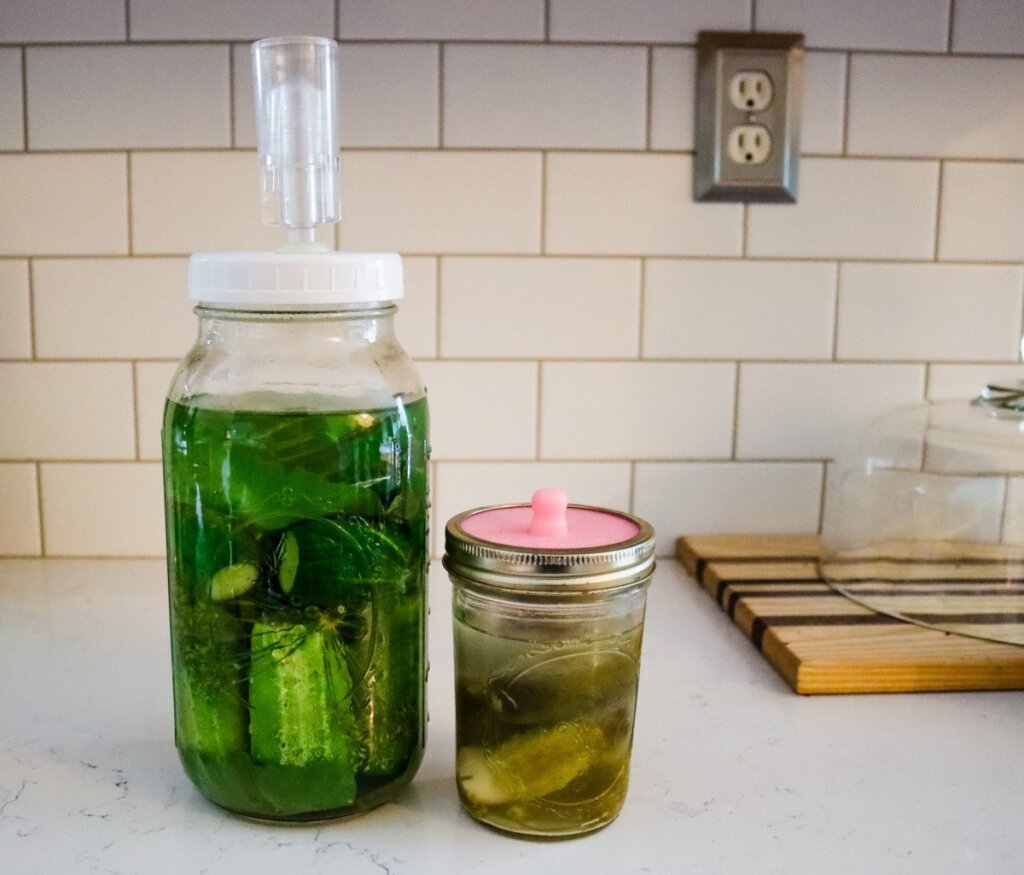
Listen to the full podcast, Episode #92 Old-fashioned Saltwater Brine Pickles, of the Pioneering Today Podcast, where we don’t just inspire you, but give you the clear steps to create the homegrown garden, pantry, kitchen, and life you want for your family and homestead.
Why I Love This Recipe
Ya'll know how much I love me a good, crunchy pickle… every year during harvest season I'm whipping up batches of my great-grandmother's mustard pickles, these fermented pickles, bread and butter refrigerator pickles, and I can't forget my favorite pickled asparagus recipe that I make in the early spring!
But why should you make this quick and easy fermented pickles recipe, too? Here are eleven reasons why:
- Small Batches – When you only have a small number of ripe cucumbers, you can still preserve them because as long as you have enough glass jars, you can make as many (or as few) jars as you want. This is perfect at the beginning and end of the growing season when you usually don't have enough cucumbers ready at the same time to can a full run (aka batch). Fermentation allows for those smaller servings.
- No Heating – That's right, there's no heating up the kitchen as with traditional canning (don't worry, I still do several runs of regular pickles so my water bath canner doesn't feel jealous or left out). Boiling water, boiling brine, all equals raising the temperature by several degrees and no one wants that happening in the hot summer months.
- Saves Time – Seriously, I can have a 1/2 gallon jar of fermented pickles going in as little as 10 minutes and that includes prep time.
- Ready in One Week – Fermented pickles are usually ready to eat in about a week, whereas I let my canned pickles sit for at least 6 weeks to develop more flavor. So the total time until they're ready is much shorter.
- Inexpensive – I'm talking CHEAP! Your main ingredient (besides the cucumbers) is a couple of Tablespoons of salt and water. No cost for vinegar. If you're not growing cucumbers yourself, check out Farmer's Markets during the growing season to buy pickling cucumbers for a more affordable price.
- Sugar-free – Many canning recipes use some sugar to help cut the strong vinegar taste (it's never safe to lower the amount of vinegar to taste when canning, as this lowers the acidity level). But with this homemade fermented pickles recipe you can enjoy the flavor of pickles without the sugar.
- Flavor Control – For safety reasons, canning pickles leaves you with the pucker power of the vinegar, but fermented pickles allow you to “lessen” the sour punch by shortening the number of days they ferment. (I like a strong sour taste, but not all do.)
- Probiotics – Free probiotics and better gut health? Have you seen the price tag on probiotics in the store? Yikes! These are totally free, and you're getting your veggies in, too.
- Easy Preservation Method – This quick and easy fermented pickles recipe will preserve your food and can be stored in the refrigerator for months. I had a jar of fermented green tomato pickles last an entire year!
- Saves Water – My water bath canner takes quite a bit of water to fill it up, but with fermented pickles, I'm only using 4 cups of water for a 1/2 gallon jar of pickles.
- Be a Modern Pioneer! – This recipe will make you feel like Ma Ingalls and a real pioneer, which is totally a legit reason in my book.
Have I convinced you yet?
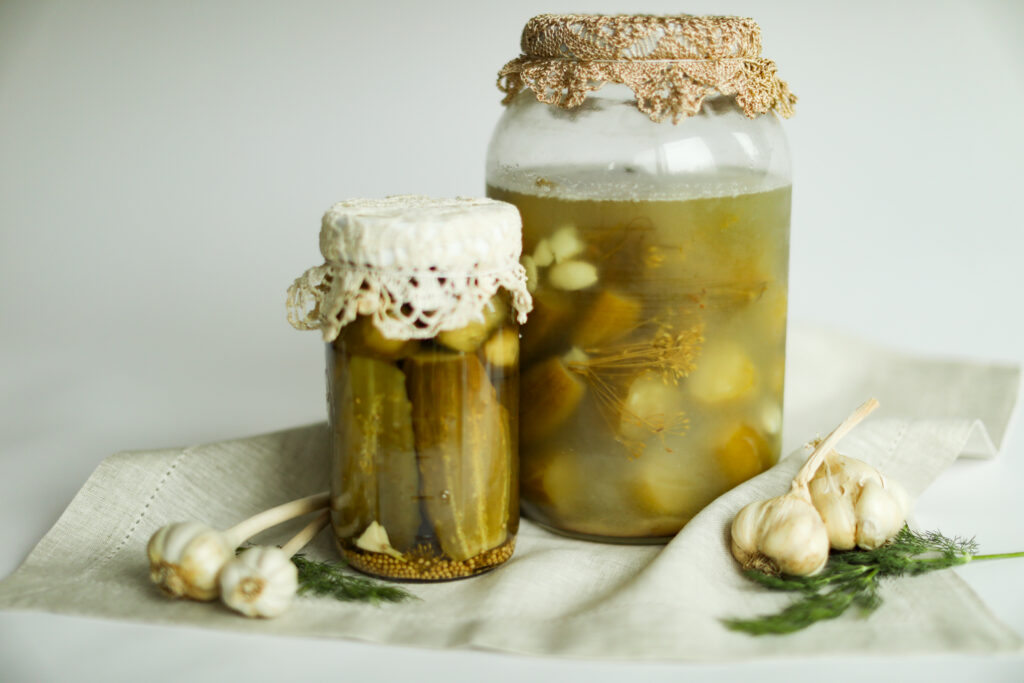
What Are Saltwater Brine Pickles (Fermented Pickles)
Saltwater brine pickles are also known as fermented pickles, but in reality, they're both just old-fashioned salt and water pickles that have gone through a natural fermentation process.
This is something many of our great-grandparents knew how to make, and many of them had barrels full of fermenting pickles in a crock.
Fermented vegetables are quickly becoming popular again. Fermentation is a form of preservation using a saltwater brine that creates a fermented culture of beneficial lactic acid microbes. Think probiotics exactly as God made them.
Keep in mind that the fermented pickles from the store may be slightly pasteurized for consistency and the safety of transporting the product. But once you know how simple they are to make at home, you'll never need to buy them again!
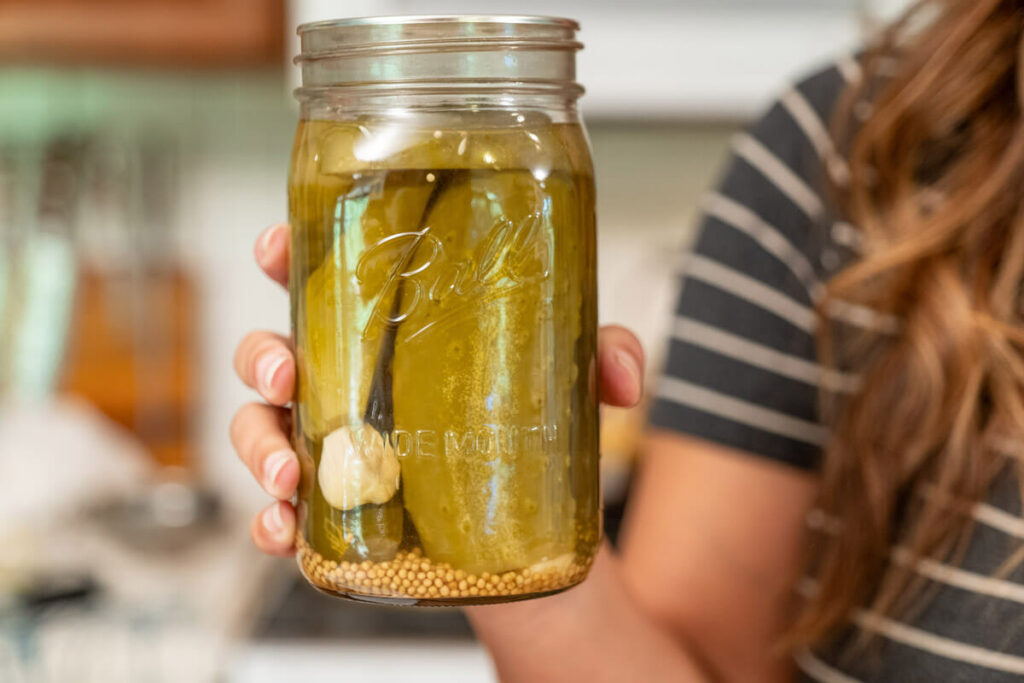
Fermented Pickles vs. Canned Pickles
While there is certainly enough room in my heart for both fermented pickles and my beloved garlic dill pickle recipe, fermented pickles have not been heated, and the naturally occurring enzymes and beneficial vitamins are still fully present (even heightened!).
When you water bath can pickles in a vinegar brine (aka vinegar pickles), you're essentially killing all organisms that may cause the pickles to spoil when stored at room temperature.
Even refrigerator pickles are different than fermented pickles. The difference here is you still pour a hot vinegar-based brine over the pickles, but instead of water bath canning them, they're placed in the refrigerator.
There are certainly places for all the above methods, but fermented pickles have my heart because they're the quickest and easiest recipe to follow. Plus they allow me to put cucumbers up as they're ripe in the garden.
It's important to note that many of the fermented store-bought pickles have most likely been pasteurized to stop the fermentation process. So making these pickles at home is the best option!
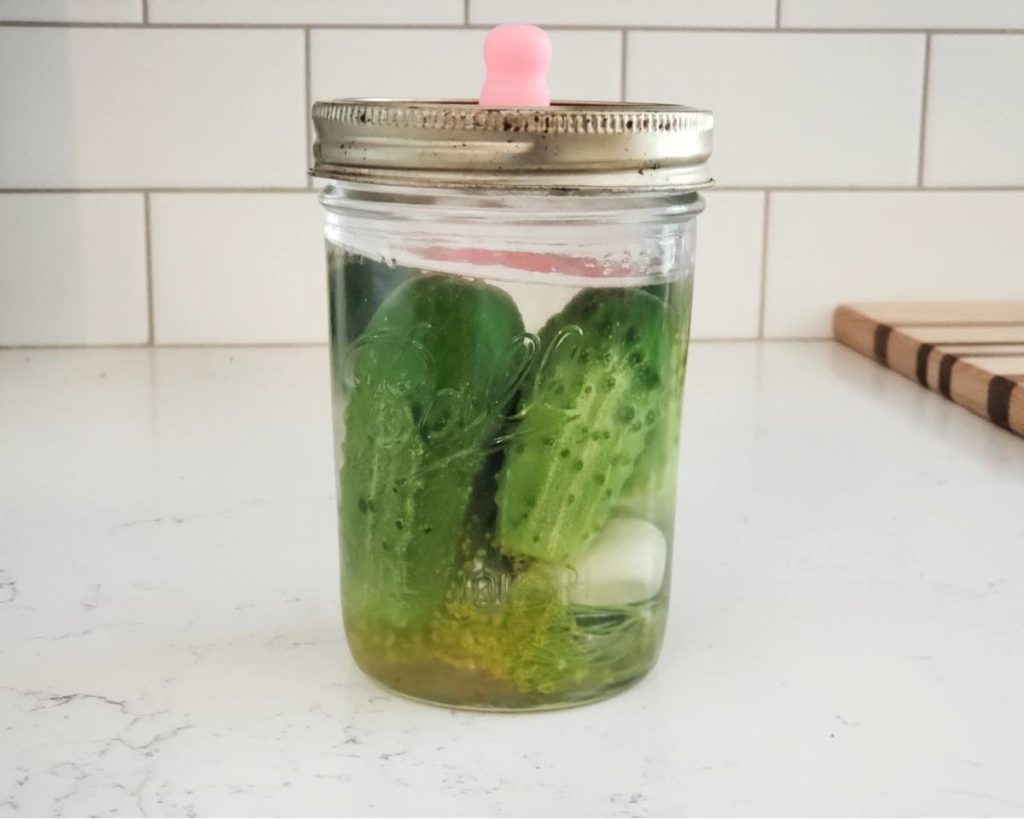
What is Fermentation?
Fermentation is a form of food preservation, especially great for fruits and vegetables. Before we had refrigeration, freezers, and even one of my main loves in life, the Mason jar, fermented foods were a common food found in many pioneer homes.
They would pack their harvest into barrels and crocks with water and salt and leave them to do their thing. The naturally occurring bacteria (and sometimes yeasts) break down the vegetable's sugars into acid, carbon dioxide gas, and other flavor compounds.
The acid produces a tartness in the vegetable, and the carbon dioxide gives it that fizzy, almost carbonated effect. Once properly fermented, the acid keeps the vegetables safe by inhibiting bad bacterial growth.
Making fermented pickles is relatively easy and can be done with pretty much any fruit or vegetable.
Are Fermented Foods Healthy?
The beauty of fermented food is that fermentation actually makes the food more nutritious due to being more easily digested and used by your body because of the cultures. (Source) That's why fermented foods are one of the digestive remedies our great-grandmothers used.
Did you know that some new studies in science are showing that our immune system is actually in our gut and that beneficial bacteria helps your digestive tract, therefore your immune system as well?
While I adore my canner, I'm discovering fermented foods are quickly becoming my second preserving love. The health benefits of this quick and easy fermented pickles recipe are many because the food is still raw and has the addition of probiotics, score!
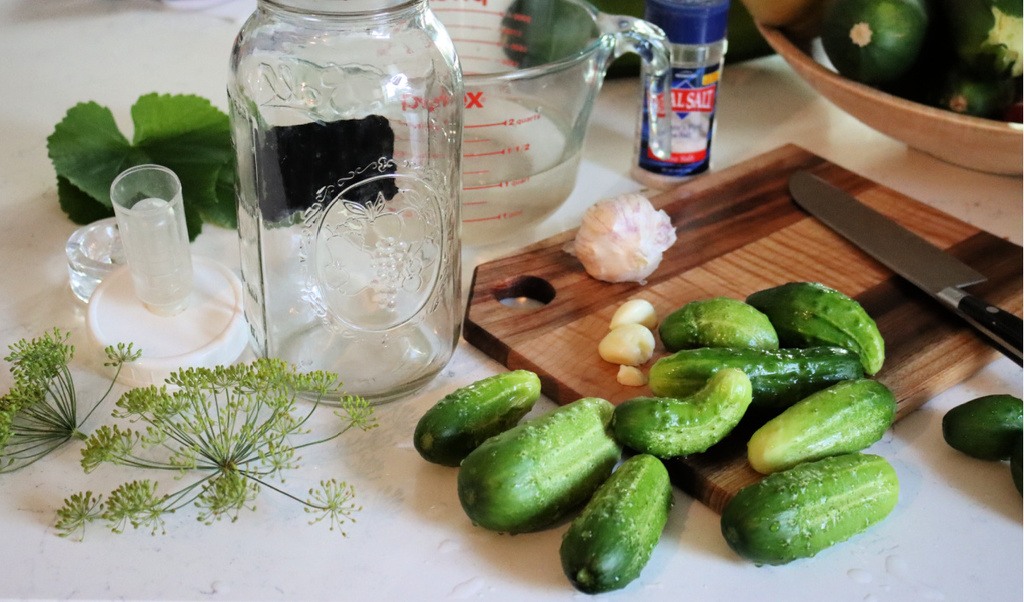
Quick & Easy Fermented Pickles Recipe
Supplies Needed
- Pickling lid- these are special lids (also called airlock lids) that help keep oxygen out, which helps keep mold and bacteria out of your ferment, keeping your ferment healthy and happy. I've tried fermenting without these, and with the exception of sauerkraut, have found these to be so worth it and haven't had to throw any food out due to mold since using them. I also love these silicone Mason jar fermenting lids too.
- Fermenting Weight- you can use a small cup, a glass fermenting weight, or anything that will keep the contents below the brine. These fermenting cups go right inside the jar and are by far the cheapest I've found.
- Fermenting Crock- this is best for doing things like sauerkraut or kimchi, I prefer the fermenting lid on half-gallon or quart jars for things like cucumbers and green beans due to having batches spoil in the crocks. The cabbage tends to be hardier.
- My book, Hand Made: The Modern Guide to Made-from-Scratch Living has some of my favorite fermented recipes in it, along with tons of other Hand Made tutorials and goodies. Go grab your copy now (because you know you'll forget later).
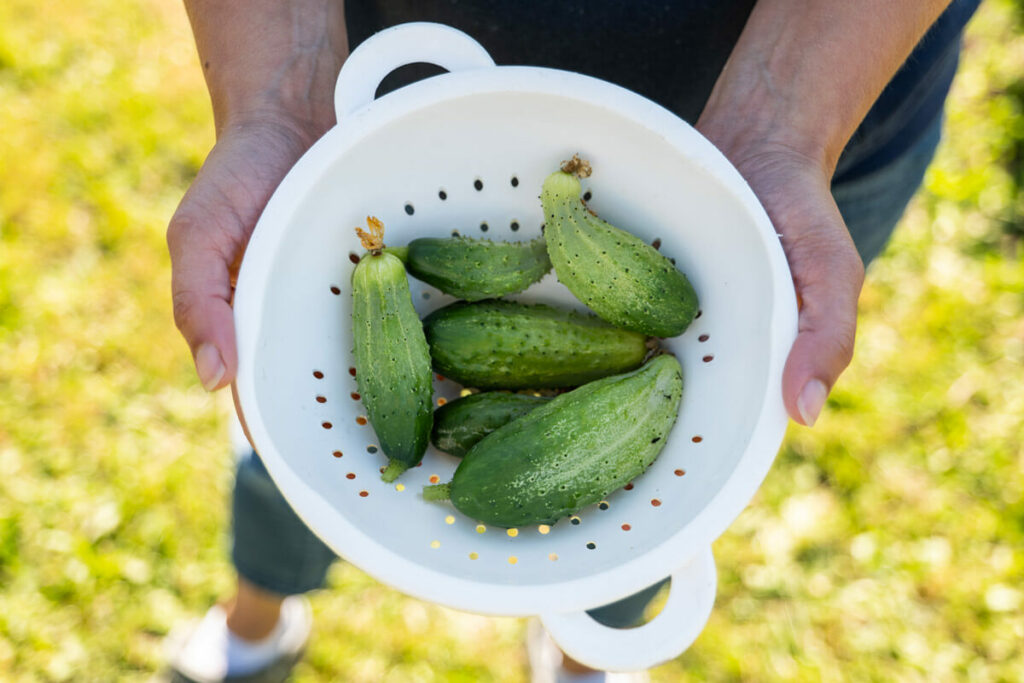
Ingredients Needed
- Pickling cucumbers – Cukes, kirby, Pro Tip: Do not use sliced cucumbers for fermentation, they will get too soft, too quickly (and no one likes a soggy pickle).
- Salt- the correct salt will make a huge difference in the success of your fermentation. Do not use kosher salt, table salt, pickling salt or canning salt. The best choices for salt are unrefined sea salts with no additives listed on the packaging, this is the salt I use for fermenting. Celtic Sea Salt-Light Gray or Redmond's Real Salt (I buy it in a 10-pound bucket here).
- Fresh dill – I think fresh dill is best, but you can also use dried dill weed or dill seeds.
- Garlic – Whole garlic cloves
- Brine (a combination of salt and water)
- Grape leaves (optional) or bay leaves
- Pickling spices, caraway seeds, mustard seeds or black peppercorns (optional) red pepper flakes
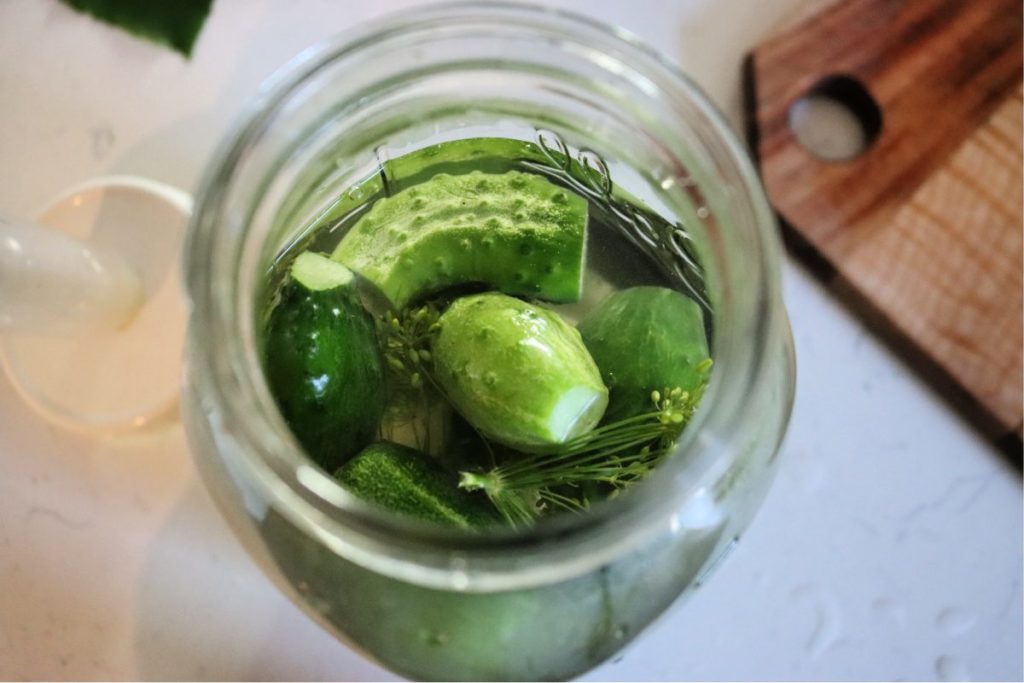
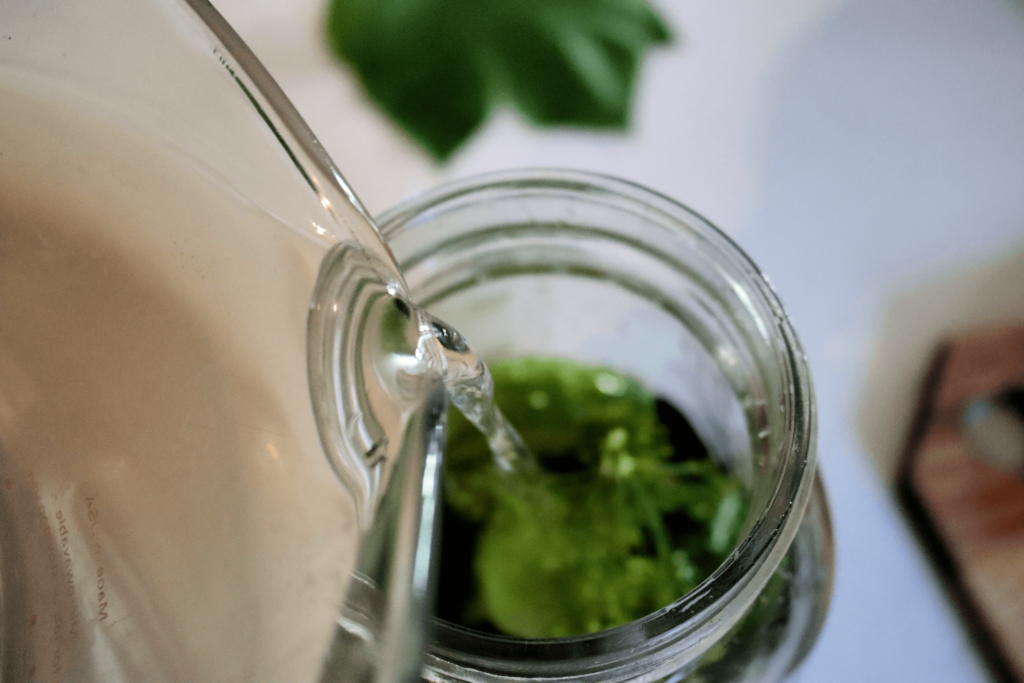
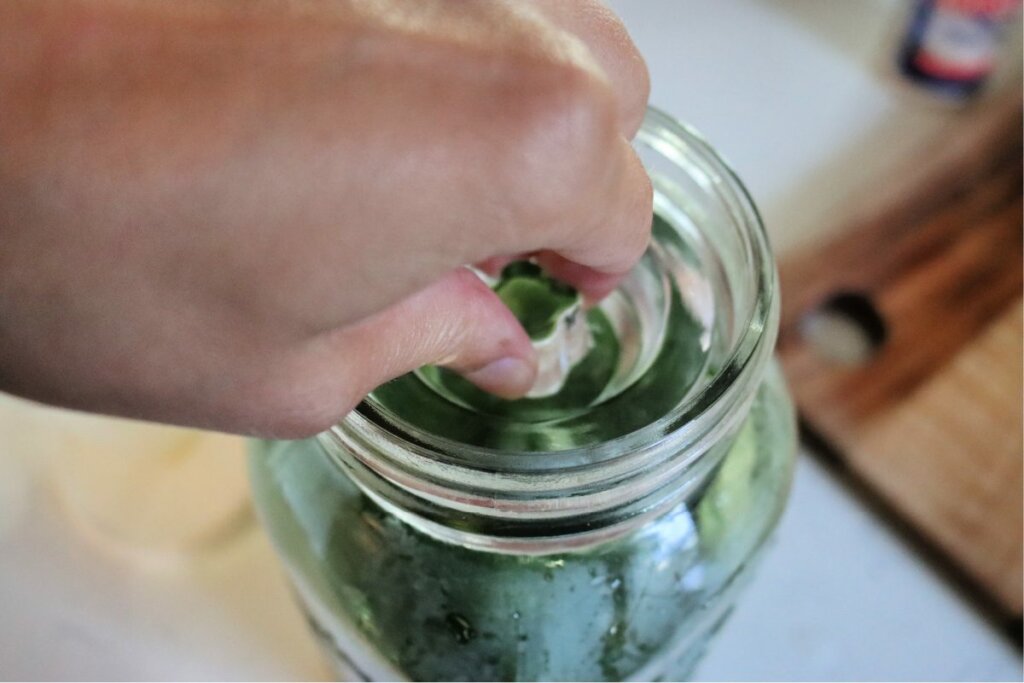
Step-by-Step Directions
- Gather all your ingredients – this recipe whips up super quickly when you have all your ingredients and supplies ready to go.
- Wash all equipment very well – It's important you're working with very clean supplies as you don't want to introduce any bad bacteria (or even soap residue) to your ferments.
- Mix up your brine – Use 2 Tablespoons of salt to 1 quart (4 cups) of water. Stir the salt into water until it's dissolved. It's recommended to use bottled spring water, filtered water, or well water. We don't want chlorine, you can either boil water with chlorine in it for 10 minutes or let it sit on the counter overnight.
- Pack your vegetables into the clean container leaving a 2-inch headspace – Even though we're not canning this recipe, headspace is essential to ensure all food stays submerged below the surface of the brine. Headspace is the space between the top of the jar and the top of the food). Just like any pickle making, the freshness, and quality of ingredients are going to determine the end product. As fresh as possible is best. (Use these 7 tips for crunchy pickles every time.)
- Fill the jar with the brine a 1-inch headspace – leave space because your weight will displace the water further and you don't want it to overflow your jar.
- Place a weight into the jar to keep the food beneath the brine surface – This is very important, if food rises above the liquid, it may mold. I prefer the fermenting weights as pictured below, but a small washed glass baby food jar will work as well.
- Place a lid on the jar – preferably a fermenting lid as pictured below, the goal is to keep the oxygen out and make it airtight. A regular two-piece canning lid can work. However, you'll need to observe your ferment carefully and, if pressure is building, give your jar a burp every day or so by unscrewing the metal band until you see the air escape, then tighten the band again. (You can usually tell pressure is building up when the metal lid is domed upward.)
- Let pickles sit! That's really all it takes to ferment your pickles. (Be sure to read my tips below on how long to ferment the pickles.)
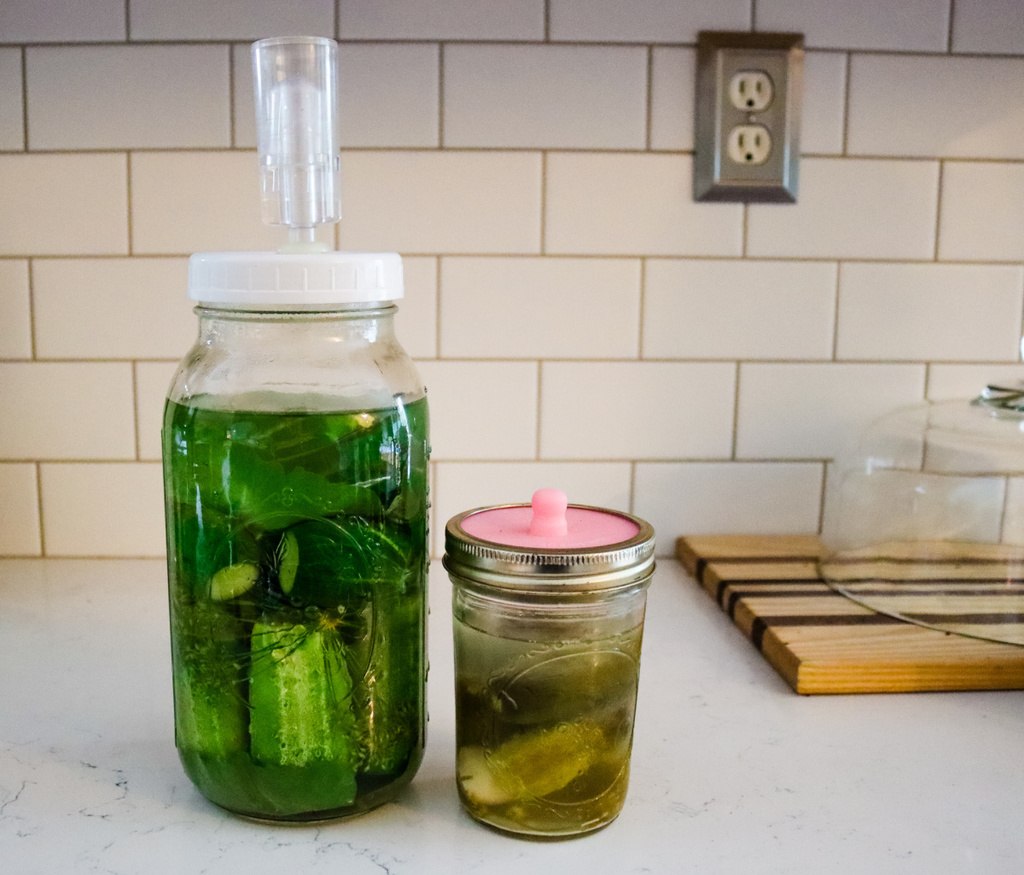
How Long to Ferment Pickles
Put the jar in a warm area (70 degrees Fahrenheit is ideal but anywhere from 65 degrees to 80 degrees Fahrenheit is fine) out of direct sunlight and not next to any appliances. Ferment for 4 days.
After a day or two, you'll notice the presence of bubbles and you may notice a cloudy brine. These are joyous signs that your ferment is working!
Check the taste of your pickles after a few days. If they're not “tangy” enough, let them continue to ferment. It sometimes takes up to 10 days if the room is cold.
When they're done fermenting, they must be moved to the fridge or a similar cold area. Take off the fermenting lid and replace it with a two-piece metal canning lid and band. They will keep for months in the fridge, but they're not shelf stable for the pantry.
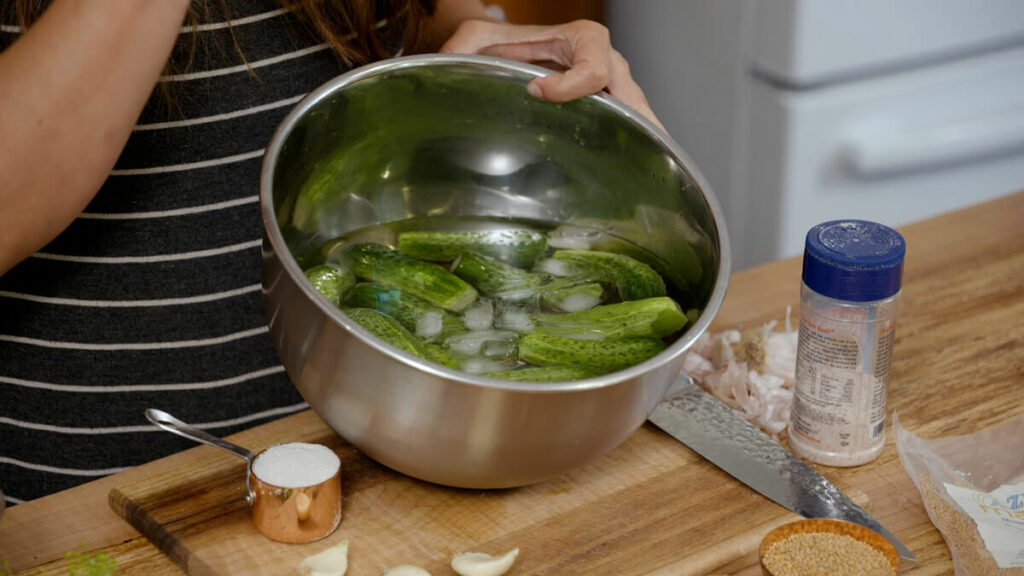
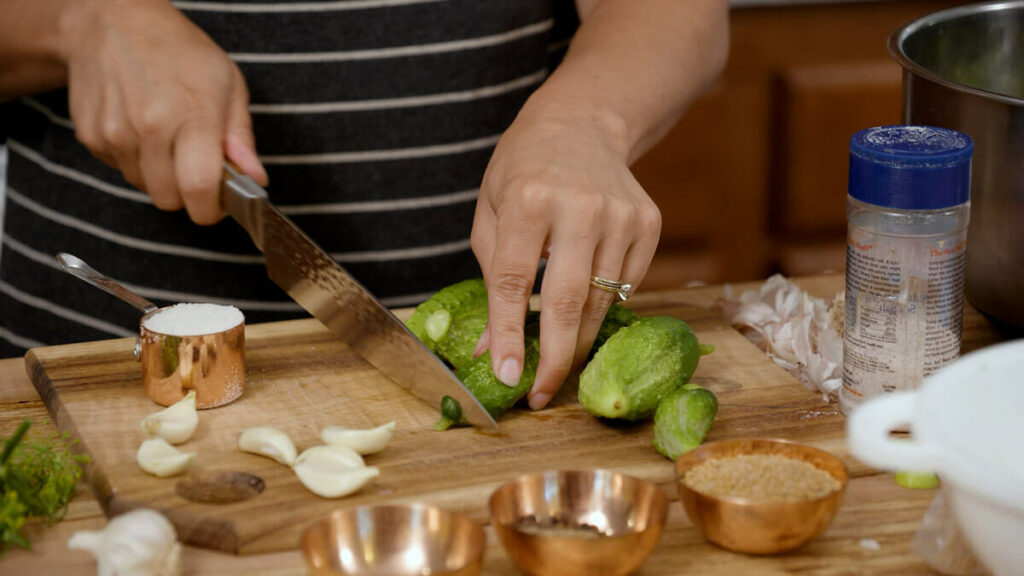
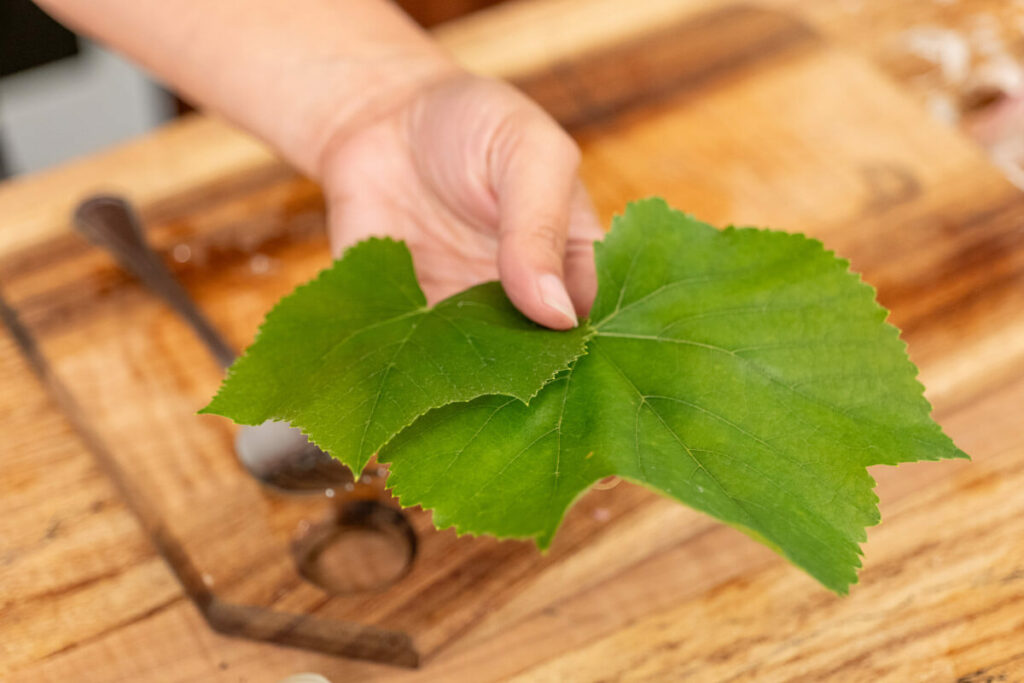
Tips for Getting the Best Pickles
- Grape Leaves – Add 1 fresh grape leaf, oak leaf, horseradish leaf, cherry leaf or 1 tsp black tea to your jar before fermenting. These ingredients include tannins that will help keep the pickles crispy and crunchy.
- Freshness – Use pickles that are as fresh as possible. If you start with a limp cucumber, you will NOT end up with a crunchy pickle.
- Remove Stem & Blossom Ends – Remove both the stem and blossom ends off the cucumber. The blossom end contains an enzyme that will result in mushy pickles.
- Fermentation Weights – Use a fermentation weight to keep all food below the brine.
- Fermentation Lid – Use a fermentation lid. If you don't have a fermentation lid, be sure to burp your jar every day or two.
- Taste Test – Taste your pickles after 2 days and continue to ferment until desired sourness is achieved.
- Store Correctly – Store finished pickles in the refrigerator.
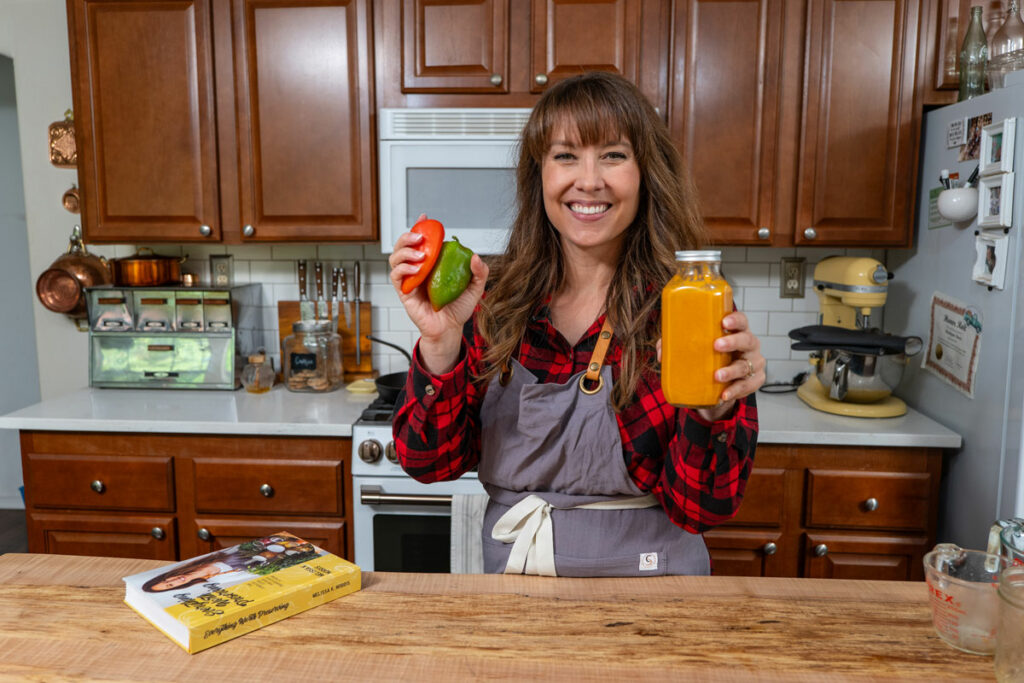
More Posts You May Enjoy
- The Best Fermented Hot Sauce Recipe
- How to Ferment Peppers
- Fermentation for Health Benefits
- How to Store Lemons (For a Year!) – Fermented Lemons
- Fresh Fermented Salsa Recipe
- Kahm Yeast (What, Why & Does it Ruin a Ferment)
- Ultimate Guide to Fermenting Vegetables
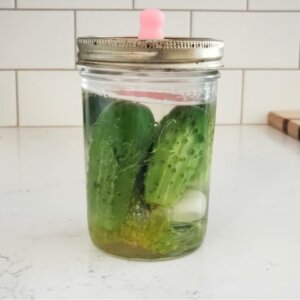
Fermented Pickle Recipe Old-fashioned Saltwater Brine Pickles
Ingredients
Brine for fermenting
- 2 Tablespoons salt
- 4 cups water
- cucumbers to fill wide mouth 1/2 gallon jar
- 2 heads dill
- 4 to 5 cloves garlic or more
Instructions
- Clean 1/2 gallon (or 2 wide-mouth quart jars) Mason jar.
- Make your brine, use 2 Tablespoons of salt to 1 quart of water (4 cups). Stir salt into water until it's dissolved.
- Pack your vegetables into the clean container leaving a 2 inch head space (space between top of jar and the top of the food). Just like any pickle making, the freshness and quality of ingredients going in determines the end product. As fresh as possible is best.
- Fill the jar with the brine a 1 inch head space. Place a weight into the jar to keep the food beneath the brine surface. This is very important, if it rises above, it may mold.
- Place a lid on the jar, preferably a fermenting lid below, the goal is to keep the oxygen out and make it air tight.
- Put the jar in warm area (70 degrees Farenheit is ideal but down to 65 degrees Farenheit is also fine) out of direct sunlight and not next to any appliances. Ferment for 4 days.
- After a day or two you'll notice the presence of bubbles and the water will turn cloudy. These are joyous signs!
- Check the taste of your pickles after a few days. If they're not "tangy" enough, let them continue to ferment. It sometimes takes up to 10 days if the room is cold.
- Take off the fermenting lid and replace with a two piece metal canning lid and band. They will keep for months in the fridge, but they're not shelf stable for the pantry.
- When they're done fermenting, they must be moved to the fridge or a similar cold area.
Notes
- you can add 1 fresh grape leaf to the bottom of the jar for a crispier pickle
- make sure you remove both ends of the pickles
